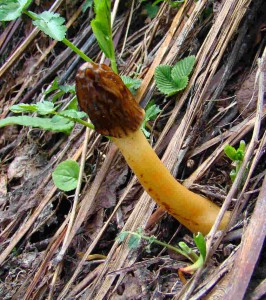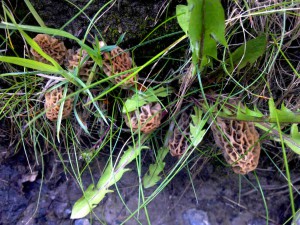
Morchella esculenta (Guchhi)
Morchella esculenta, commonly known as Guchhi, is one of the most prized wild mushrooms found in the Great Himalayan National Park (GHNP) and surrounding alpine and subalpine regions. Renowned for its culinary and medicinal value, this distinctive fungus is easily recognized by its honeycomb-like, sponge-textured cap and earthy aroma.
Habitat and Distribution
Guchhi mushrooms thrive in high-altitude forest clearings, especially in moist areas rich in organic matter. They are typically found during spring, emerging after snowmelt in temperate coniferous and mixed forests—often near oak (Quercus), deodar (Cedrus deodara), and pine (Pinus wallichiana) trees. GHNP’s well-preserved forest floors offer an ideal habitat for these mushrooms, which are notoriously difficult to cultivate and are mostly collected from the wild.
Ecological Importance
Morchella esculenta is a saprophytic fungus, meaning it decomposes dead organic matter and contributes significantly to nutrient cycling in forest ecosystems. In the GHNP, where biodiversity and ecosystem health are closely monitored, the presence of Guchhi mushrooms is often associated with rich soil quality and healthy forest dynamics.
| Local name | Guchhi, common morel, morel, yellow morel, morel mushroom, and sponge morel |
| Botanical name | Morchella esculenta |
| Family | Morchellaceae |
| Description and uses | Morchella esculenta, like all morels, are among the most highly prized of all edible mushrooms. It is one of the most readily recognized of all the edible mushrooms and highly sought after. Each fruit body begins as a tightly compressed, greyish sponge with lighter ridges, and expands to form a large yellowish sponge with large pits and ridges raised on a large white stem. The pitted yellow-brown caps measure 2–7 cm broad by 2–10 cm tall, and are fused to the stem at its lower margin, forming a continuous hollow. The fungus fruits are found under hardwoods during a short period in the early spring with the onset of showers. Fruit bodies are sometimes found solitary, but more often in groups, on the ground in a variety of habitats. Laboratory experiments suggest that the polysaccharides present in M. esculenta fruit bodies have several medicinal properties, including anti-tumor effects, immuno regulatory properties, fatigue resistance, and antiviral effects. Extracts from the fruit bodies have antioxidant properties |
Economic and Cultural Significance
Among the local communities near GHNP, Guchhi mushrooms are a high-value non-timber forest product (NTFP). Due to their rarity and demand, especially in gourmet cuisine and traditional medicine, dried Guchhi can fetch premium prices in markets across India and abroad. Harvesting Guchhi also provides an important seasonal income for local residents, though overharvesting is a concern that has prompted calls for sustainable collection practices.
Conservation Concerns
Given their limited growing window, habitat specificity, and commercial demand, Morchella esculenta is considered vulnerable in some areas. GHNP’s conservation framework helps protect these mushrooms by limiting access to core forest zones and promoting awareness about sustainable harvesting. Ongoing research into their ecology, life cycle, and potential for cultivation is also crucial.
Conclusion
Morchella esculenta (Guchhi) stands out as a valuable and ecologically significant species within the Great Himalayan National Park. Its presence enriches both the biodiversity and the cultural landscape of the region. Protecting Guchhi mushrooms and educating communities about their ecological role and sustainable harvesting is essential for preserving this Himalayan delicacy for future generations.




